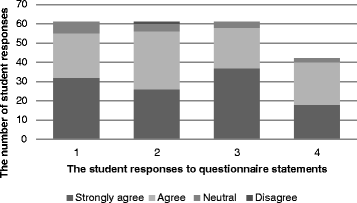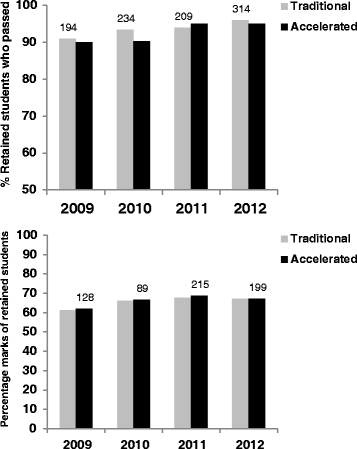Reduced withdrawal and failure rates of accelerated nursing students enrolled in pharmacology is associated with a supportive intervention
- PMID: 26830810
- PMCID: PMC4736620
- DOI: 10.1186/s12909-016-0570-z
Reduced withdrawal and failure rates of accelerated nursing students enrolled in pharmacology is associated with a supportive intervention
Abstract
Background: To reduce nursing shortages, accelerated nursing programs are available for domestic and international students. However, the withdrawal and failure rates from these programs may be different than for the traditional programs. The main aim of our study was to improve the retention and experience of accelerated nursing students.
Methods: The academic background, age, withdrawal and failure rates of the accelerated and traditional students were determined. Data from 2009 and 2010 were collected prior to intervention. In an attempt to reduce the withdrawal of accelerated students, we set up an intervention, which was available to all students. The assessment of the intervention was a pre-post-test design with non-equivalent groups (the traditional and the accelerated students). The elements of the intervention were a) a formative website activity of some basic concepts in anatomy, physiology and pharmacology, b) a workshop addressing study skills and online resources, and c) resource lectures in anatomy/physiology and microbiology. The formative website and workshop was evaluated using questionnaires.
Results: The accelerated nursing students were five years older than the traditional students (p < 0.0001). The withdrawal rates from a pharmacology course are higher for accelerated nursing students, than for traditional students who have undertaken first year courses in anatomy and physiology (p = 0.04 in 2010). The withdrawing students were predominantly the domestic students with non-university qualifications or equivalent experience. The failure rates were also higher for this group, compared to the traditional students (p = 0.05 in 2009 and 0.03 in 2010). In contrast, the withdrawal rates for the international and domestic graduate accelerated students were very low. After the intervention, the withdrawal and failure rates in pharmacology for domestic accelerated students with non-university qualifications were not significantly different than those of traditional students.
Conclusions: The accelerated international and domestic graduate nursing students have low withdrawal rates and high success rates in a pharmacology course. However, domestic students with non-university qualifications have higher withdrawal and failure rates than other nursing students and may be underprepared for university study in pharmacology in nursing programs. The introduction of an intervention was associated with reduced withdrawal and failure rates for these students in the pharmacology course.
Figures


Similar articles
-
Group work: Facilitating the learning of international and domestic undergraduate nursing students.Educ Health (Abingdon). 2015 May-Aug;28(2):124-9. doi: 10.4103/1357-6283.170123. Educ Health (Abingdon). 2015. PMID: 26609012
-
Factors for attrition in an accelerated baccalaureate nursing program.J Nurs Educ. 2010 Jun;49(6):359-62. doi: 10.3928/01484834-20100217-05. Epub 2010 Jun 3. J Nurs Educ. 2010. PMID: 20210286
-
Facilitating program and NCLEX-RN success in a generic BSN program.Nurs Forum. 2007 Jan-Mar;42(1):31-8. doi: 10.1111/j.1744-6198.2007.00063.x. Nurs Forum. 2007. PMID: 17257393
-
The impact of community college transfer on entry-level baccalaureate nursing student retention.Nurse Educ. 2008 Jan-Feb;33(1):45-8. doi: 10.1097/01.NNE.0000299498.30743.5e. Nurse Educ. 2008. PMID: 18091472 Review.
-
Enhancing success in BSN nursing education for minority nurses.ABNF J. 2005 Jan-Feb;16(1):8-10. ABNF J. 2005. PMID: 15813480 Review.
References
-
- HealthWorkforce Australia. Health Workforce 2025 – Doctors, Nurses and Midwives [https://www.hwa.gov.au/our-work/health-workforce-planning/health-workfor...]. Accessed 3 Sept 2015.
-
- American Association of Colleges of Nursing. Nursing shortages [http://www.aacn.nche.edu/media-relations/fact-sheets/nursing-shortage]. Accessed 3 Sept 2015.
-
- Canadian Federation of Nurses Unions. The Nursing workforce. [https://nursesunions.ca/sites/default/files/2013.backgrounder.nursing_wo...]. Accessed 3 Sept 2015.
Publication types
MeSH terms
LinkOut - more resources
Full Text Sources
Other Literature Sources

